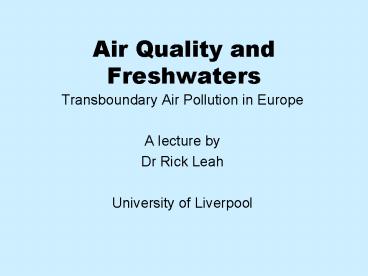Air Quality and Freshwaters - PowerPoint PPT Presentation
Title:
Air Quality and Freshwaters
Description:
oxides of nitrogen from motor vehicles and the industrial burning of fossil ... The Dipper (Cinclus cinclus ) Biol202. 27. Remediation by neutralisation ... – PowerPoint PPT presentation
Number of Views:54
Avg rating:3.0/5.0
Title: Air Quality and Freshwaters
1
Air Quality and Freshwaters
- Transboundary Air Pollution in Europe
- A lecture by
- Dr Rick Leah
- University of Liverpool
2
(No Transcript)
3
What causes acidity in the atmosphere?
- sulphur dioxide, mainly from power stations,
- oxides of nitrogen from motor vehicles and the
industrial burning of fossil fuels (gas, oil and
coal). - Another form of nitrogen pollution, ammonia, is
emitted especially in rural areas, e.g. from
manure spread on farmland and from farm animals.
4
(No Transcript)
5
(No Transcript)
6
(No Transcript)
7
Three related Problems
- Acid deposition
- Nitrogen Eutrophication
- Ground-level Ozone
8
Transboundary Pollution
9
(No Transcript)
10
(No Transcript)
11
Total deposition 1988 - 1992 Source The critical
load / NILU. Maps SKMe Norwegian Mapping
Authority - Environmental unit
12
Three Major Changes
- Lowering of pH (increase in H ion)
- Loss of basic ions (eg Ca2)
- Increase in Aluminium
- others such as mobilisation of Hg
13
Interaction with Forestry
- Organic humus - Tendency to acidification
- Export of basic ions with forest products
- Makes system more sensitive to acid
14
Historical Position
- Arguments over cause and effect
- Complexity of problem leaves room for manoeuvre
for vested interests - Scientific work did not start until major
environmental effects were widespread - Evidence from the environment itself
Palaeolimnology
15
Diatoms
16
(No Transcript)
17
Acid tolerant
Acid sensitive
18
Critical Loads
- To help quantify effects and relate them to the
acid deposited, an "effects based" approach,
known as critical loads, has been developed. - The critical load is a measure of sensitivity of
the environment to pollutants.
19
The Critical Load
"the quantity of pollution that a part of the
environment can tolerate without harmful effects
occurring". Deposition above that limit may
damage plants and animals. Where acidity critical
loads are large, more acid deposition can be
tolerated, but areas with small acidity critical
loads are very sensitive to acidification.
20
Capacity (to neutralise inputs) ie amounts
of Na K Ca Mg Al
Intensity
Sensitivity
21
Areas where excess deposition over the
sensitive acidity critical loads is unlikely
(pink), where excess is likely (red) and where
the excess is high (black) as given by the
deposition of sulphur, nitrogen oxide and
ammonia
22
2010 (estimated)
1992-94
23
Total deposition 1988 - 1992 Source The critical
load / NILU. Maps SKMe Norwegian Mapping
Authority - Environmental unit
24
Atlantic salmon (Salmo salar)
Effects of acidity are felt at all trophic
levels Fish, especially salmonids are
particularly susceptible
25
Map Regional distribution of areas with fish
stocks affected by acidification in Norway
1950-1990. Source DN, Directorate for Nature
Management.
26
The Dipper (Cinclus cinclus )
27
Remediation by neutralisation
- Lime (CaCO3) is abundant and relatively cheap
- Reduces acidity but does not return to pristine
condition because of alkalinity - Can cause problems of increased toxicity of
dissolve aluminium
28
1,000 tonnes of lime used Calculated from
government expenditure on lime, (with a fixed
price of NOK 1,000 per tonne through the whole
period. Source Directorate for Nature
Management).
29
Treating the Symptoms
- In 1995 lime was used over 2,500 locations in
Norway covering a precipitation area of about
6,400 square kilometres - In 1994 8.5 million were used on liming. The
amount increased to 79 million in 1995 and then
to 100 million in 1996
30
Treatment High Costs
- If the entire area of Southern Norway where the
critical load has been exceeded should receive
sufficient lime, the costs would be approximately
290 million according to the Norwegian Institute
for Water Research.
31
Removal at source is better than Remediation
32
(No Transcript)
33
(No Transcript)
34
Legislation
- 1979 Convention on Long Range Transboundary Air
Pollution (LRTAP) - 43 Signatories around the Northern Hemisphere
35
Legislation for Reductions in Acid Emissions (I)
- Early Protocols for sulphur dioxide and oxides of
nitrogen set simple targets for all countries - a 30 reduction of sulphur emissions by 1993
- decreasing emission levels of oxides of
nitrogen to those of 1987 (by 1994)
36
Excess depositions of SO2 in Europe (in tons per
square kilometer). No colourno data. Source
EMEP
37
Emissions of SO2 in 1000 tons, and by source.
Source Statistics Norway ("Natural Resources
and the Environment 1997") / SFT
38
Emissions of NOx in 1000 tons, and by
source Source Statistics Norway ("Natural
Resources and the Environment 1997") / SFT
39
Legislation for Reductions in Acid Emissions (II)
- In 1994, the new 'effects based' Protocol for
sulphur, based on critical loads, was agreed in
Oslo. - This defined a target for each European country
based on its pollutant emissions, the costs of
abatement and the contribution those emissions
made to acid deposition on sensitive ecosystems
across Europe.
40
The Multi-pollutant, Multi-effect Protocol
- was signed in Gothenburg in 1999.
- It takes into account effects of acidity, excess
nutrient nitrogen and also photochemical oxidants
(low level ozone).
41
Recovery
42
Recovery
- Slow processes are involved
- Calculations show that to achieve recovery at the
most sensitive sites, emissions of sulphur,
oxides of nitrogen and ammonia must be decreased
further still.
43
- For some sensitive areas, however, critical loads
may be unattainable with current emission control
technology, so recovery may not be possible
through emission decreases alone in the
foreseeable future - Other methods may be used to aid their recovery.
For example, in many lakes in Scandinavia, the
addition of lime continues to be used as an
interim measure for neutralising acidification.































